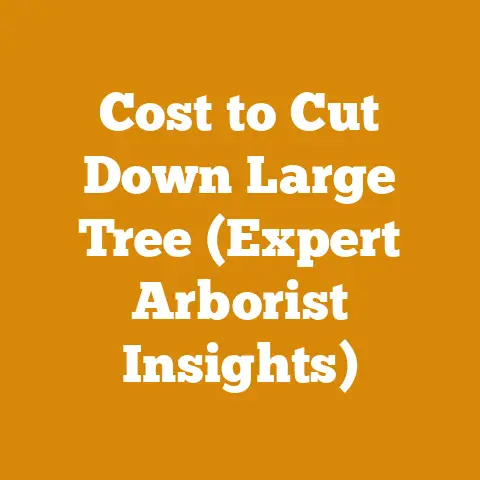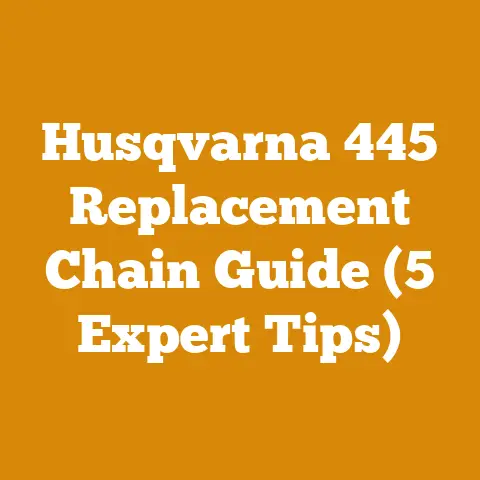How to Repair Damaged Bark on Apple Trees (Pro Tree Care Tips)
Ignoring damaged bark on your apple trees is like ignoring a gaping wound on a loved one – it will only get worse. As a seasoned arborist and someone who has spent countless hours in orchards, I’ve seen firsthand the devastating effects of neglected bark injuries. But don’t despair, repairing damaged bark is often achievable, and with the right knowledge and techniques, you can save your precious apple trees. This guide is designed to equip you with the professional tree care tips you need to understand, address, and prevent bark damage. I’ll even share a few budget-friendly strategies I’ve learned along the way to keep your orchard healthy without breaking the bank.
Understanding Apple Tree Bark Damage
Bark damage is more than just an aesthetic issue; it’s a serious threat to the health and longevity of your apple trees. The bark is the tree’s protective layer, shielding it from pests, diseases, and environmental stressors. When this barrier is compromised, the tree becomes vulnerable to a host of problems.
Common Causes of Bark Damage
- Physical Injury: This is perhaps the most common cause. Lawn mowers, weed whackers, and even careless gardeners can easily wound the bark. Animals, such as deer, rodents, and rabbits, also contribute to bark damage through gnawing and rubbing, especially during winter months.
- Environmental Factors: Sunscald, caused by rapid temperature fluctuations in winter, can damage bark on the south and west sides of trees. Frost cracks, similar to sunscald, occur when the sap inside the tree freezes and expands, causing the bark to split.
- Pests and Diseases: Certain insects, like borers, can tunnel under the bark, disrupting nutrient flow. Diseases such as canker can also cause bark lesions and decay.
- Grafting and Pruning Issues: Improper grafting techniques or poorly executed pruning cuts can create entry points for pathogens and weaken the bark.
Identifying Different Types of Bark Damage
- Sunscald: Look for elongated, sunken areas on the south or southwest side of the trunk. The bark may be cracked or peeling. I’ve seen entire rows of young trees succumb to sunscald after a harsh winter.
- Animal Damage: Gnaw marks are a telltale sign of rodents or rabbits. Deer rubbing often results in vertical scrapes and torn bark. I remember one particularly frustrating winter where deer decimated the lower branches of my young apple trees, costing me a significant portion of the anticipated yield.
- Canker: Canker appears as sunken, discolored areas on the bark, often surrounded by a raised callus. The bark may be oozing sap.
- Borer Damage: Small holes in the bark, often accompanied by sawdust-like frass, indicate borer infestation.
- Frost Cracks: Vertical cracks in the bark, often on the south side of the trunk, are characteristic of frost damage.
Why Bark Damage Matters: The Consequences
- Increased Susceptibility to Pests and Diseases: A damaged bark allows pests and pathogens to easily enter the tree, leading to infestations and infections.
- Reduced Nutrient and Water Transport: The bark contains the phloem, which transports nutrients from the leaves to the roots, and the xylem, which transports water from the roots to the leaves. Damage to the bark disrupts this flow, weakening the tree.
- Structural Weakness: Extensive bark damage can compromise the structural integrity of the tree, making it more susceptible to wind damage and breakage.
- Reduced Fruit Production: Stressed trees produce less fruit, and the quality of the fruit may be diminished.
- Tree Death: In severe cases, extensive bark damage can lead to the death of the tree.
Assessing the Damage: Determining the Severity and Extent
Before you start repairing the damaged bark, it’s crucial to accurately assess the severity and extent of the injury. This will help you determine the appropriate course of action and the likelihood of successful repair.
Visual Inspection: What to Look For
- Size of the Damaged Area: Measure the length and width of the damaged area. Larger wounds are more difficult to heal.
- Depth of the Damage: Determine how deep the damage penetrates. Is it just the outer bark, or does it reach the cambium layer (the layer of actively growing cells beneath the bark)? Damage that reaches the cambium is more serious.
- Location of the Damage: Bark damage near the base of the tree is more critical than damage higher up on the branches. Damage that girdles the trunk (completely encircles it) is particularly dangerous.
- Evidence of Pests or Diseases: Look for signs of insect infestation (holes, frass) or disease (oozing sap, discolored bark).
- Overall Tree Health: Assess the overall health of the tree. Is it vigorous and producing healthy foliage, or is it stressed and declining? A healthy tree is more likely to recover from bark damage.
Determining the Impact on the Tree’s Health
- Girdling: If the bark damage completely encircles the trunk, it is considered girdling. Girdling prevents the flow of nutrients and water, and it will eventually kill the tree if not addressed.
- Cambium Damage: Damage to the cambium layer disrupts the tree’s ability to grow and heal. If the cambium is exposed, it is vulnerable to drying out and infection.
- Infection Risk: Open wounds are susceptible to infection by fungi and bacteria. Look for signs of infection, such as discoloration, oozing sap, or a foul odor.
When to Call a Professional Arborist
While you can often repair minor bark damage yourself, there are situations where it’s best to consult a professional arborist.
- Extensive Damage: If the damage is large, deep, or girdles the trunk, it’s best to seek professional help.
- Suspected Disease: If you suspect that the bark damage is caused by a disease, an arborist can diagnose the problem and recommend appropriate treatment.
- Uncertainty: If you’re unsure about the best course of action, it’s always better to err on the side of caution and consult a professional. I’ve learned this lesson the hard way, trying to fix a problem myself only to make it worse.
Cost Considerations for Professional Arborist Services
- Consultation Fee: Arborists typically charge a consultation fee for assessing the damage and providing recommendations. This fee can range from \$75 to \$200, depending on the arborist’s experience and location.
- Repair Costs: The cost of repairing bark damage can vary widely depending on the severity of the damage, the size of the tree, and the arborist’s rates. Minor repairs may cost a few hundred dollars, while more extensive repairs can cost several thousand.
- Tree Removal Costs: If the tree is severely damaged and cannot be saved, the arborist may recommend removing it. Tree removal costs can range from \$500 to \$2,000 or more, depending on the size and location of the tree.
- Preventive Measures: Arborists can also provide preventive measures to protect your trees from future bark damage. These measures may include installing tree guards, applying protective sprays, or pruning to improve air circulation. The cost of these measures will vary depending on the specific services provided.
My Personal Experience: I once tried to save an apple tree with extensive bark damage near the base of the trunk. I attempted to repair it myself, but the damage was too severe, and the tree eventually died. In hindsight, I should have consulted a professional arborist sooner. While it would have cost me money, it might have saved the tree.
Repairing Minor Bark Damage: DIY Techniques
For minor bark damage, you can often repair the damage yourself using simple tools and techniques. Here are some common DIY methods:
Cleaning and Sanitizing the Wound
- Remove Loose Bark: Use a sharp, clean knife or pruning shears to carefully remove any loose or jagged bark around the edges of the wound.
- Clean the Wound: Use a clean cloth or brush to remove any dirt, debris, or insects from the wound.
- Sanitize the Wound: Apply a disinfectant solution to the wound to kill any bacteria or fungi. A common disinfectant solution is a 10% bleach solution (1 part bleach to 9 parts water). Be sure to rinse the wound thoroughly with clean water after applying the disinfectant.
Applying Wound Dressing or Sealant
- Purpose of Wound Dressing: Wound dressings are designed to protect the wound from pests, diseases, and drying out. They can also help to promote healing.
- Types of Wound Dressing: There are several types of wound dressings available, including tree wound paint, pruning sealant, and natural tree wound dressings.
- Application Techniques: Apply the wound dressing to the entire surface of the wound, making sure to cover all exposed cambium. Follow the manufacturer’s instructions for application.
My Personal Experience: I’ve found that using a natural tree wound dressing made from beeswax and propolis (a resinous mixture collected by honeybees) works well for minor bark damage. It’s non-toxic and helps to protect the wound while promoting healing.
Bridge Grafting: A More Advanced Technique
Bridge grafting is a technique used to repair girdled trees. It involves connecting the bark above and below the damaged area with scions (small branches) to restore the flow of nutrients and water.
- When to Use Bridge Grafting: Bridge grafting is used when the bark is completely girdled, preventing the flow of nutrients and water.
- Materials Needed: You will need scions (small branches) from the same type of tree, grafting wax, grafting tape, and a sharp knife.
- Step-by-Step Instructions:
- Prepare the Scions: Cut scions from healthy branches, making sure they are slightly longer than the damaged area.
- Prepare the Bark: Cut flaps of bark above and below the damaged area.
- Insert the Scions: Insert the scions under the bark flaps, making sure the cambium layers are aligned.
- Secure the Scions: Secure the scions with grafting tape.
- Apply Grafting Wax: Apply grafting wax to all exposed surfaces to protect the grafts from drying out.
My Personal Experience: I’ve successfully used bridge grafting to save several apple trees that were girdled by rodents. It’s a time-consuming process, but it can be very rewarding to see a tree recover and thrive.
Budget-Friendly Alternatives to Commercial Products
- Homemade Wound Dressing: You can make your own wound dressing by mixing equal parts of clay, cow manure, and water. This mixture will help to protect the wound and promote healing.
- Natural Tree Wound Dressing: As mentioned earlier, a natural tree wound dressing made from beeswax and propolis is a great alternative to commercial products. You can often find these ingredients at local beekeeping supply stores.
- DIY Tree Guards: You can make your own tree guards using wire mesh, plastic tubing, or burlap. These guards will protect the bark from animal damage. I’ve found that wrapping the base of young trees with burlap during the winter months is an effective and inexpensive way to prevent rodent damage.
Cost Breakdown of DIY Repairs
Let’s break down the costs of some DIY bark repair projects:
| Item | Estimated Cost | Notes |
|---|---|---|
| Pruning Shears | \$20 – \$50 | A good quality pair of pruning shears will last for many years. |
| Grafting Knife | \$15 – \$30 | A sharp grafting knife is essential for making clean cuts. |
| Grafting Wax | \$10 – \$20 | A small container of grafting wax will last for several repairs. |
| Grafting Tape | \$5 – \$10 | Grafting tape is used to secure the scions in place. |
| Wire Mesh (Tree Guard) | \$10 – \$20 | A roll of wire mesh can be used to make several tree guards. |
| Burlap (Tree Wrap) | \$5 – \$10 | A roll of burlap can be used to wrap the base of several trees. |
| Homemade Wound Dressing | \$2 – \$5 | The cost of the ingredients for homemade wound dressing is minimal. |
| Total | \$67 – \$155 | This is an estimated cost for basic DIY bark repair supplies. The actual cost may vary depending on the specific products you choose and the quantity you need. Remember to factor in the cost of your time as well. While DIY repairs can save money, they also require time and effort. |
Protecting Your Apple Trees: Prevention is Key
The best way to deal with bark damage is to prevent it from happening in the first place. Here are some preventive measures you can take:
Installing Tree Guards
- Purpose of Tree Guards: Tree guards protect the bark from physical injury caused by lawn mowers, weed whackers, and animals.
- Types of Tree Guards: There are several types of tree guards available, including plastic guards, wire mesh guards, and burlap wraps.
- Installation Techniques: Install tree guards around the base of the tree, making sure they are tall enough to protect the bark from animals.
My Personal Experience: I’ve found that using a combination of wire mesh guards and burlap wraps is the most effective way to protect my apple trees from animal damage. The wire mesh guards prevent deer from rubbing against the bark, while the burlap wraps protect the bark from rodents and rabbits.
Protecting Against Sunscald
- Whitewashing the Trunk: Whitewashing the trunk of the tree with a diluted latex paint can help to reflect sunlight and prevent sunscald.
- Wrapping the Trunk: Wrapping the trunk with burlap or tree wrap can also help to protect against sunscald.
- Proper Pruning: Proper pruning can help to improve air circulation and reduce the risk of sunscald.
Controlling Pests and Diseases
- Regular Inspections: Regularly inspect your trees for signs of pests or diseases.
- Proper Sanitation: Remove any dead or diseased branches and leaves from around the tree.
- Insecticides and Fungicides: Use insecticides and fungicides as needed to control pests and diseases. Be sure to follow the manufacturer’s instructions carefully.
- Promote Beneficial Insects: Encourage beneficial insects, such as ladybugs and lacewings, to prey on pests.
Proper Pruning Techniques
- Timing of Pruning: Prune apple trees in late winter or early spring, before the buds begin to swell.
- Making Proper Cuts: Make clean, angled cuts just above a bud or branch. Avoid leaving stubs, as these can attract pests and diseases.
- Removing Dead or Diseased Branches: Remove any dead or diseased branches to prevent the spread of infection.
- Thinning the Canopy: Thin the canopy to improve air circulation and sunlight penetration.
Budgeting for Preventive Measures
Here’s a look at the costs associated with preventive measures:
| Item | Estimated Cost | Notes |
|---|---|---|
| Tree Guards | \$10 – \$30 each | The cost of tree guards will vary depending on the type and size. |
| Burlap (Tree Wrap) | \$5 – \$10 | A roll of burlap can be used to wrap the base of several trees. |
| Whitewash Paint | \$10 – \$20 per gallon | A gallon of whitewash paint will cover several trees. |
| Insecticides/Fungicides | \$15 – \$30 per application | The cost of insecticides and fungicides will vary depending on the product and the size of the tree. |
| Pruning Tools (Saw, Loppers) | \$50 – \$100 | A good quality pruning saw and loppers will last for many years. |
| Total (per tree, initial) | \$90 – \$190 | This is an estimated initial cost per tree for preventive measures. Ongoing costs for insecticides/fungicides and replacing tree wraps will need to be factored in annually. Regular pruning, while requiring time and effort, is an essential and relatively low-cost preventive measure. |
Regional Variations in Cost: These costs can vary significantly based on your location. For example, in areas with high deer populations, more robust (and expensive) deer fencing might be necessary. Similarly, the cost of insecticides and fungicides can vary depending on local regulations and availability.
Long-Term Tree Care for Healthy Bark
Maintaining healthy bark is an ongoing process that requires long-term commitment to tree care.
Regular Monitoring and Inspection
- Frequency of Inspections: Inspect your trees regularly, at least once a month during the growing season.
- What to Look For: Look for signs of bark damage, pests, diseases, or other problems.
- Record Keeping: Keep a record of your inspections and any treatments you apply.
Fertilization and Watering
- Proper Fertilization: Fertilize your trees in the spring with a balanced fertilizer.
- Adequate Watering: Water your trees regularly, especially during dry periods.
- Soil Testing: Conduct soil tests to determine the nutrient levels in your soil and adjust your fertilization accordingly.
Mulching
- Benefits of Mulching: Mulching helps to retain moisture in the soil, suppress weeds, and protect the roots of the tree.
- Types of Mulch: There are several types of mulch available, including wood chips, bark mulch, and straw.
- Application Techniques: Apply a layer of mulch around the base of the tree, making sure to keep it away from the trunk.
Addressing Underlying Issues
- Identifying Root Problems: Root problems can weaken the tree and make it more susceptible to bark damage. Look for signs of root problems, such as stunted growth, yellowing leaves, or dieback.
- Improving Drainage: Poor drainage can lead to root rot and other problems. Improve drainage by amending the soil or installing drainage systems.
- Correcting Soil pH: The pH of the soil can affect the tree’s ability to absorb nutrients. Correct the soil pH by adding lime (to raise the pH) or sulfur (to lower the pH).
Budgeting for Long-Term Tree Care
Creating a budget for long-term tree care ensures you’re prepared for the ongoing costs of maintaining healthy apple trees.
| Item | Estimated Annual Cost (per tree) | Notes show up in cost analysis.
| Mulch | \$20 – \$40 per cubic yard | Mulch helps retain moisture, suppress weeds, and protect roots. Prices depend on the type of mulch (wood chips, bark mulch, straw).






